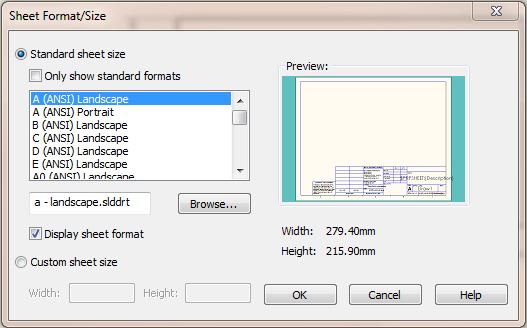Using a Custom Sheet Format
Do you want your SOLIDWORKS drawings to have a main title block on the first sheet, and a smaller title block on all additional sheets? This can easily be done in SolidWorks.
Figure 1: A multiple sheet drawing with a smaller sheet format on sheet 2.
Sheets, Formats, and Templates
To help explain the process, we will start off reviewing some basic info about drawing sheets, sheet formats, and drawing templates. The sheet format has information about the drawing and contains the title block, drawing border, and other descriptive annotations. The drawing sheet is the “paper space” that can contain the actual drawing views and dimensions. Together, these make up the SOLIDWORKS drawing file. Each sheet, or page, of a SOLIDWORKS drawing file can have its own sheet format.
Figure 2: The Sheet Format contains the title block and drawing border.
When you start a brand new drawing, you select your desired drawing template. Once open, this file is just an empty drawing file and will appear identical to what the template looked like when it was created. Starting or opening a drawing like this does not force SOLIDWORKS to load, or even refresh, the drawing Sheet Format. This is important behavior that is often over looked. SOLIDWORKS will only try to retrieve, and load, the Sheet Format file if you add a new sheet to a drawing. This also explains why you are able to open existing drawings, even ones created by different companies, without being required to have access to their actual sheet format file. In this same scenario, if you try to add a 2nd sheet and SOLIDWORKS cannot locate the sheet format file it will give you a pretty direct warning message.
Figure 3: SOLIDWORKS cannot find the Sheet Format file when adding a new sheet to the drawing.
Procedure
Now that we have covered the background topics, here are the steps for accomplishing this.
- Setup the initial sheet format for the drawing front page and do a File- “Save Sheet Format”. Do this twice naming it something that represents both pages. In my example, I have these two identical sheet formats named “B- Landscape-MCAD First Sheet” and “B- Landscape-MCAD Additional Sheet”.
- Open up a new drawing file and change the sheet1 properties to point to the desired Sheet Format that is to be used for the additional sheets. You can do this with the “Browse” button.
- After this property is set, we want to save the drawing template to over write the previous one. This is done in the File- Save As- dialogue box and changing the file type to ‘drawing template’.
- Next, open the Sheet Format that is supposed to be used for the additional sheets. At this point, it will still resemble what the first sheet looked like. Edit this Sheet Format to make it look as desired for the additional sheets. Do a File- Save Sheet Format to use this to overwrite the sheet format file that is used on the additional sheets.
- Now test by starting a new drawing using the drawing template we saved earlier, and then adding a 2nd sheet.
The new drawing opens up with the ‘sheet 1’ title block because that is what it looked like when it was last saved. The additional sheets look different than the first because it only tries to ‘reload’ the sheet format when a new sheet is added.
Figure 4: you can Save Sheet Format from the File pull-down menu.
Figure 5: the sheet properties allows you to browse to desired Sheet Formats.
Want to learn more about SOLIDWORKS Drawings? Browse available training classes in your area.
Author: Greg Buter

 Blog
Blog 



